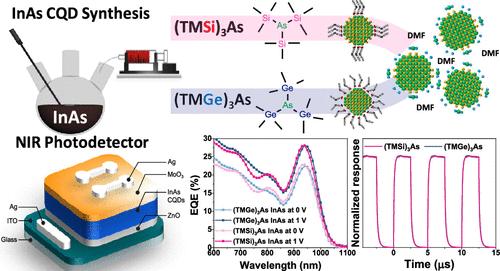当前位置:
X-MOL 学术
›
J. Am. Chem. Soc.
›
论文详情
Our official English website, www.x-mol.net, welcomes your
feedback! (Note: you will need to create a separate account there.)
Resurfacing of InAs Colloidal Quantum Dots Equalizes Photodetector Performance across Synthetic Routes
Journal of the American Chemical Society ( IF 14.4 ) Pub Date : 2024-08-28 , DOI: 10.1021/jacs.4c06202
Hyeong Woo Ban 1 , Maral Vafaie 1 , Larissa Levina 1 , Pan Xia 1 , Muhammad Imran 1 , Yanjiang Liu 1 , Amin Morteza Najarian 1 , Edward H Sargent 1
Journal of the American Chemical Society ( IF 14.4 ) Pub Date : 2024-08-28 , DOI: 10.1021/jacs.4c06202
Hyeong Woo Ban 1 , Maral Vafaie 1 , Larissa Levina 1 , Pan Xia 1 , Muhammad Imran 1 , Yanjiang Liu 1 , Amin Morteza Najarian 1 , Edward H Sargent 1
Affiliation

|
The synthesis of highly monodispersed InAs colloidal quantum dots (CQDs) is needed in InAs CQD-based optoelectronic devices. Because of the complexities of working with arsenic precursors such as tris-trimethylsilyl arsine ((TMSi)3As) and tris-trimethylgermyl arsine ((TMGe)3As), several attempts have been made to identify new candidates for synthesis; yet, to date, only the aforementioned two highly reactive precursors have led to excellent photodetector device performance. We begin the present study by investigating the mechanism, finding that the use of the cosurfactant dioctylamine plays a crucial role in producing monodispersed InAs populations. Through quantitative analysis of ligands on the surface of InAs CQDs, we find that (TMGe)3As leads to In-rich characteristics, and we document the presence of an amorphous In-oleate shell on the surface. This we find causes surface defects, and thus, we develop materials processing strategies to remove the surface shell with a view to achieving efficient charge transfer in CQD solids. As a result, we develop resurfacing protocols, tailored to each dot synthesis, that produce balanced In-to-As stoichiometry regardless of synthetic input, enabling us to fabricate NIR photodetectors that achieve best-in-class EQEs at 940 nm excitons (25–28%, biased), independent of the synthetic pathway.
中文翻译:

InAs 胶体量子点的表面重整可均衡各个合成路线的光电探测器性能
基于 InAs CQD 的光电器件需要合成高度单分散的 InAs 胶体量子点 (CQD)。由于砷前体(例如三-三甲基甲硅烷基胂((TMSi) 3 As)和三-三甲基甲锗基胂((TMGe) 3 As))的复杂性,人们进行了多次尝试来确定新的合成候选物;然而,迄今为止,只有上述两种高反应性前体实现了优异的光电探测器器件性能。我们通过研究其机制开始本研究,发现辅助表面活性剂二辛胺的使用在产生单分散 InAs 群体中起着至关重要的作用。通过对InAs CQD表面配体的定量分析,我们发现(TMGe) 3 As具有富In特性,并记录了表面存在非晶In-油酸酯壳层。我们发现这会导致表面缺陷,因此,我们开发了材料加工策略来去除表面壳,以期在 CQD 固体中实现有效的电荷转移。因此,我们开发了针对每个点合成量身定制的表面重整协议,无论合成输入如何,都能产生平衡的 In-to-As 化学计量,使我们能够制造在 940 nm 激子(25– 28%,有偏差),与合成途径无关。
更新日期:2024-08-28
中文翻译:

InAs 胶体量子点的表面重整可均衡各个合成路线的光电探测器性能
基于 InAs CQD 的光电器件需要合成高度单分散的 InAs 胶体量子点 (CQD)。由于砷前体(例如三-三甲基甲硅烷基胂((TMSi) 3 As)和三-三甲基甲锗基胂((TMGe) 3 As))的复杂性,人们进行了多次尝试来确定新的合成候选物;然而,迄今为止,只有上述两种高反应性前体实现了优异的光电探测器器件性能。我们通过研究其机制开始本研究,发现辅助表面活性剂二辛胺的使用在产生单分散 InAs 群体中起着至关重要的作用。通过对InAs CQD表面配体的定量分析,我们发现(TMGe) 3 As具有富In特性,并记录了表面存在非晶In-油酸酯壳层。我们发现这会导致表面缺陷,因此,我们开发了材料加工策略来去除表面壳,以期在 CQD 固体中实现有效的电荷转移。因此,我们开发了针对每个点合成量身定制的表面重整协议,无论合成输入如何,都能产生平衡的 In-to-As 化学计量,使我们能够制造在 940 nm 激子(25– 28%,有偏差),与合成途径无关。































 京公网安备 11010802027423号
京公网安备 11010802027423号